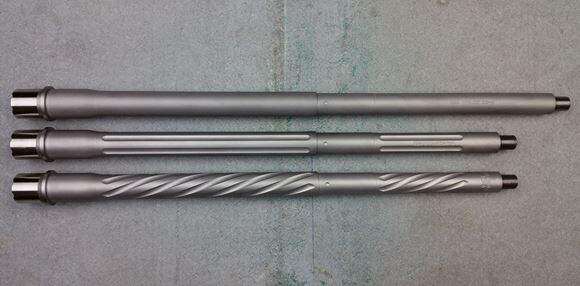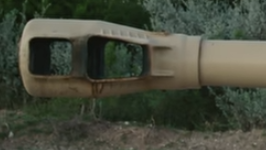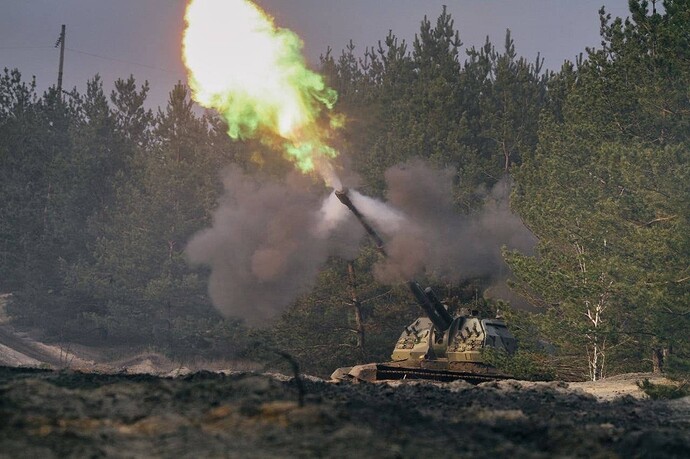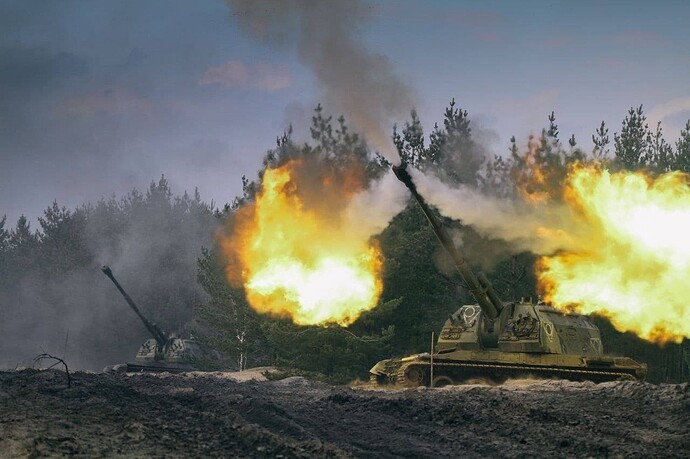Some may be caused by shadows.
In other cases I have noticed that the black has a clear limit (hard edge) while you would expect it fades to the barrel. Considering that German barrels were treated with a dark grey anti-heat primer, and it is not rare to see them unpainted, I wonder if these black muzzle brakes are just primed replacements installed on a still functional (and already painted) barrel.
Remembering my high-school physics, I don’t see how trying to blow gas straight back does any good. The transverse baffles get hit by the expanding gases and are pushed forward as they kill the gas’ forward momentum, making them vent sideways by the pressure of more gas behind them. This pushes the brake forward, countering some of the recoil forces. Adding more baffles to redirect the flow backwards would have the sideways-flowing gases hit the secondary baffles, pushing them out sideways as they kill the gas’ sideways momentum, resulting in the gas getting pushed back away from the muzzle by the pressure of more gas behind them that’s already been turned sideways. This doesn’t contribute any significant amount to cancelling the recoil, and it adds stresses to the muzzle brake, reducing its lifespan. A brake that angles the diverted gas slightly backwards would be just as effective as one that reversed the direction of the gas completely, and it’s not blowing hot gases back at the shooter.
Technically, baffles that turn the gas jet 180 degrees backward is straight back down the barrel. Baffles that turn the gas jet outwards, then backward along the barrel would be needed to achieve what Robin said…

![]()
You’ve answered your own querstion.
If you’ve seen it, then you know what you saw. But on this forum folks that have never smelled Wolf ***** will tell you all kinds of things.
Blast effects from escaping gas is not linear. Think about it everyone - high pressure gas will not encroach on the ambient air pressure nearby? We did some research when we wanted to fortify our house in Iraq. Plus we all learned about blast effects handling demo. The old phrase “If you can see the charge, the charge can see you” is quite valid. But if you can’t see the charge, guess what? It can still see you! Like with Chuck Norris, you may be seconds from death.
Shooting the comped Sig pictured above definitely gets carbon on my slide over time. I’m the one who cleans it. (only occasionally, as carbon on my slide affects functionality not one whit) But the compensator does not blow carbon 180 degrees rearward. It doesn’t have to.
And guys complain about the barrels that have the loaded chamber indicator - a small notch at the rear of the barrel - fouling their optics. Even though there is no straight path from the cut out to their optic. How can this be?
That high pressure moves to an area of low pressure. It’s physics. Now how much ended up on German barrels in WWII I neither know nor care. That wasn’t the OP"s question anyway. but the fact is that ANY powder with carbon in its make up has the potential the create soot over time. Obviously more time equals more soot.
Yeah, funny, as many gun as I have cleaned. Muzzle brake not an issue.
Now if you wanna talk muzzle break instead of brake and tempatures, walla…
Nitpicker …
I think that’s the guy I saw do a Glock meltdown test.
he has done a bunch of guns meltdowns. I think even a AK.
AR-15 barrel from the video posted by Mrclark7 above.
Fired until the barrel blew.
Can someone who knows this weapon tell me how it should look?
Like the top one in this image?

Is the black end on the pristine barrel painted black?
Has the paint been burned on the barrel from the video?
I see your cannon and raise you a Sherman. And a Russian D20 arty piece.
interesting with the arty. If you have enough heads standing in front of you, you can deflect the shell and live.
positive thing for Russian orcs?
Russias problem is that they are running out of heads to use for projectile deflection …
Staining around muzzle brake

Two shots later

Two more muzzle blasts


The MSTA-S actually seems to deflect gases at a 45 degree angle backwards
but the gas cloud still barely touches the barrel behind the muzzle brake.
Muzzle blast versus fridge
the abridged version
Various smaller calibers against a “zombie hand” and a “zombie head”
But how do they stand up to looted washing machines? ![]()
I think most of what we see in WW2 pics is a combo of shade, wear of camo to reveal primer, and of course brakes left in primer when the barrel is painted because they had the canvas dust bag on at the time. (How else do you get a straight edge to the effect a few inches down the barrel, away from the joint with the brake?) There might be some soot, but not enough to show in pics, and certainly not enough build-up on weapons with a combat life often measured in days! Like the “Spanish school” of advanced rust, sooting is just a fancy way to attract attention to a model…
Again, I thank YouTube for having my back.
I remember saying as much in the last sentence of this post:
My guess… the black is original factory finish (not paint). Both ends would be masked while the remaining majority of the barrel received the lighter (more protective) dull coating. That way the dimensions of the ends would not be affected making assembly more predictable.
And then there’s this:
I’ve seen people at the range start to shoot this way.
And part 2:
Jerry Miculek did one with hot dogs.
He sure does have a nice backyard!










